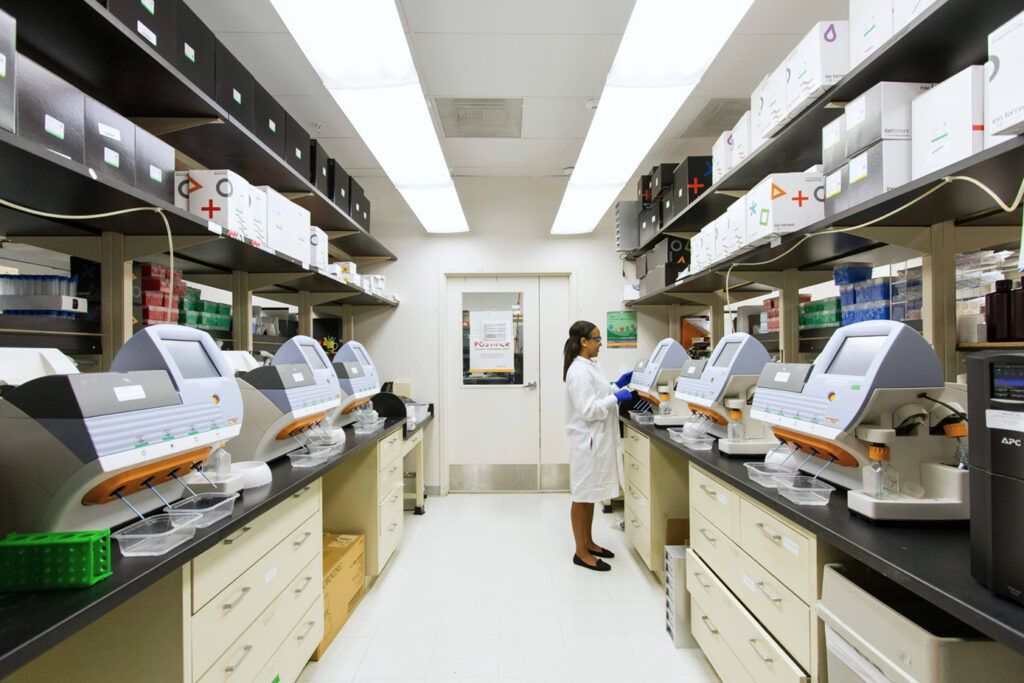By Bill Thomas | May 1, 2024
Pediatric cancer comes in many different shapes and forms, some more difficult to treat than others. For example, certain types of high-grade glioma tumors grow deep in the midline structures of the brain, far from where neurosurgeons are able to safely operate. For years, doctors treating patients with these kinds of tumors have had few options, with both radiation therapy and chemotherapy proving ineffective in improving survival rates

The tide may be turning, however. In the early 2010s, a French research group using novel technologies was able to successfully perform stereotactic biopsies on deep midline glioma patients. In 2012, another team published their findings, linking the deep-growing tumors to a mutation called H3 K27M, which seemed to implicate a biologically and clinically distinct form of glioma tumor. Thanks to this discovery, pediatric cancer researchers today are able to directly study H3 K27M tumor tissue samples.
Right now, one of the most exciting advancements in the battle against H3 K27M gliomas is the development of ONC201, also called dordaviprone, an orally administered, first-in-class small molecule imipridone therapeutic that may be able to improve patient survival rates.
ONC201 is currently in Phase 3 clinical trials. As outlined in a previous Profectus blog, Phase 3 is the final phase for clinical trials before a novel treatment can be submitted for FDA approval. Getting to this point has been a long, challenging road for ONC201’s researchers and though the finish line is inching closer, they still have a lengthy distance to travel.
“This is a drug that was first discovered maybe 10 years ago and has been in the pipeline over that course of time,” said Dr. Amanda Saratsis, who is a neurosurgeon, a PCRF Board Member and clinical development consultant for Chimerix, the biopharmaceutical company developing ONC201. “It is one of the most promising treatments that we have for this particularly terrible disease.”
Time-Intensive and Expensive

In addition to working as consultant, Dr. Saratsis is a pediatric neurosurgeon at Advocate Lutheran General Hospital in Park Ridge, IL. As such, she is cognizant of the fact that breakthroughs in pediatric cancer research don’t happen overnight.
On average, it can take around 10-17 years to develop a new drug or treatment. That includes 4-8 years of basic study and translational research and 5-7 years of clinical trials, followed by an additional 1-2 years to complete the FDA approval and registration process. For pediatric cancer patients and their loved ones, that’s a long time to have to wait in hopes of a breakthrough. Nevertheless, the time-intensive nature of the research process is crucial to ensuring the safety and efficacy of new treatment options.
“Even work done with cells in a petri dish is highly regulated by institutional review boards and scientific safety committees to ensure they are conducted properly and conditions only become more regulated as animals or humans are involved,” Dr. Saratsis explained. “I think, from that standpoint, each phase of the process is fragile and needs to be done with care and integrity.”
Even still, pediatric cancer research is often fraught with setbacks, with only about one-third of novel therapies making it from Phase 2 to Phase 3. So, what happens when an avenue of research shows promise, but the directions researchers are going in seems to lead to a dead end? They start over.
“Using the example of a novel drug, let’s say you get all the way through Phase 2 and it just isn’t making a difference in terms of outcomes for patients. What you do next is you go back to the drawing board and you ask the question, ‘Would this drug be more efficacious in a different type of disease?’ or you could ask, ‘Is it the dosing regimen or the drug delivery method that could be improved?’, or maybe ‘Could it be synergistic in combination with another type of compound?’ ” Dr. Saratsis said.
“Ultimately, negative findings help guide our fundamental understanding of a scientific process. Negative findings can steer us in the right direction when it comes to better understanding the mechanism of a disease or a given treatment’s effect on a disease.”
Unfortunately, going back to the drawing board can add years to the process of testing and receiving approval for a new treatment. And yet, as time-intensive as pediatric cancer research is, it’s just as often resource-intensive.
Roughly 40% of the total cost of bringing an oncology drug to market goes into the basic and translational stages of research. Once an avenue of research progresses to clinical trials, each phase requires more data, which means enrolling more patients. However, for rare diseases, such as H3 K27M gliomas and many other pediatric cancers, finding enough patients can be difficult.
For that reason, most trials run concurrently in multiple sites all across the country, or even internationally. In addition to necessitating a high degree of coordination and cooperation, multi-site trials need more equipment and staff members, which only adds to the financial burden.
Funding for pediatric cancer research comes from multiple sources, including grants from the federal government, private donors (including foundations and businesses), and nonprofit organizations like the Pediatric Cancer Research Foundation, which account for a full 50 percent of pediatric cancer research funding. Even then, researchers developing new medicines need to partner with organizations capable of manufacturing those drugs.
“This often requires either buy-in from a pharmaceutical company or, at an academic institution, it might be a pharmacology department,” Dr. Saratsis explained. “In other words, it takes a village. It takes really integrating with different people with different expertise to take a really good idea and bring it to bear in a clinical trial.”

It Takes a Village
There’s no shortage of obstacles in the path of pediatric cancer researchers looking to make a difference: the length of time each stage of the research process entails, the potential setbacks that could necessitate starting over again, the difficulty of enrolling patients, the complexity of coordinating multiple trial sites, and, of course, the constant need to acquire funding. What makes these challenges worth facing? The fact that every time we do, it brings us one step closer to finding safer, more effective cures – some of which will be first-time treatments for cancers that have no current cure.
All pediatric cancer research is built on the backbone of the research that came before. Just as scientists discovering the H3 K27M mutation in the 2010s paved the way for Chimerix taking ONC201 into Phase 3 clinical trials today, the breakthroughs made by pediatric cancer researchers in the 2020s will help spur science toward even greater breakthroughs in the future.
The Pediatric Cancer Research Foundation was founded on the belief that, by working together, donors, doctors, researchers, educators, patients, and families can all make a positive impact. We know that the work involved isn’t easy, which is why every contribution counts. That includes the donations that help us fund research and the insights accrued by the researchers advancing science in the lab.
“A basic scientist may spend their entire career investigating a given disease mechanism before making a major discovery. That’s a lifetime of work. At the same time, a Phase 3 clinical trial is often a global enterprise that builds on and requires the efforts of hundreds of scientists, clinicians and staff and takes years if not decades to accrue meaningful data,” Dr. Saratsis said.
“It’s all hard work and it’s all important.”

